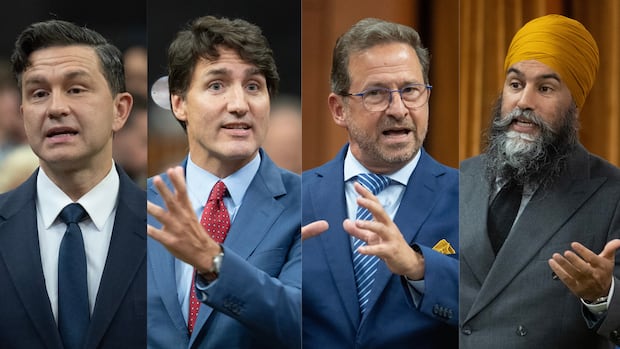
Prime Minister Justin Trudeau’s government survived a confidence vote this week with the help of the NDP and the Bloc Québécois — but the Liberals will be facing another one very soon.
The Conservatives have said repeatedly they want to bring down the government as soon as possible and have put forward another non-confidence motion already. It’s expected to go to a vote next week.
They also have three more opposition days — when opposition motions take priority over government business — between now and Christmas. They can use those days to push more confidence votes.
The NDP and Bloc also will have one opposition day each this fall, giving them an opportunity to bring forward non-confidence motions of their own.
The Bloc has sent the government a list of demands. It says that if they’re not met by the end of October, they’ll look to bring down the government in a confidence vote.
The Liberals also could face confidence votes on money bills, such as the supplementary estimates or the fall economic statement (if it includes new spending).
Here’s a breakdown of how the major parties would have to align in order to trigger an early election.
Conservative Leader Pierre Poilievre just tabled a motion of non-confidence in the House of Commons. Here’s what that means and what happens next.
If the NDP and Bloc vote with Conservatives
If both the Bloc and NDP decide at any point to vote with the Conservatives and bring down the Liberal government, the result would be a foregone conclusion.
As it stands, the Liberals have 152 seats in the House of Commons, not counting House Speaker Greg Fergus, who would only vote to break a tie.
The Conservatives have 119 seats, the Bloc has 32 and NDP has 24. Together, the three party caucuses would out-vote the Liberals 175 to 152 and the government would fall.
Both the Bloc and the NDP have candidates who recently won byelections but have yet to be sworn in as MPs. Once those candidates take their seats, each party will have an extra vote.
If either the Bloc or NDP votes against a non-confidence motion, the Liberals would continue to govern.
If the NDP abstains and Bloc votes no-confidence
MPs aren’t forced to vote on every motion. They can abstain.
If the entire NDP caucus abstains from a confidence vote while the Bloc sides with the Conservatives, that could be enough to trigger an election. It would depend on how the Greens and Independent MPs vote.
The 151 seats held by the Conservatives and the Bloc would fall one vote short of defeating the Liberals.
The two Green MPs would then decide whether the Liberal government stands or crumbles.
A combination of Green, Bloc and Conservative MPs could out-vote the Liberals and trigger an election. But if the Greens choose to back the government — as they did during Wednesday’s confidence vote — the Liberals continue to govern.
The four Independent MPs also could be a factor.
Two of the Independents — Pablo Rodriguez and Han Dong — are former Liberals who voted against the Conservative motion on Wednesday.
The other two Independent MPs are Alain Rayes, a former Conservative, and Kevin Vuong, who typically votes with the Conservatives and has expressed interest in joining the Conservative caucus. Both voted in favour of Wednesday’s non-confidence motion.
Assuming the Independent MPs continue to vote as they did this week, the Greens would continue to hold the balance of power in this scenario.
Louis-Philippe Sauvé, who recently won a Montreal byelection, will eventually take his seat and give the Bloc another vote. That still would not be enough to bring down the government without the support of the Greens.
If the Greens and NDP both abstain from a confidence vote after Sauvé is sworn in, the Conservatives and the Bloc could force a tie. In that case, Speaker Fergus, who was elected as a Liberal MP, would break the tie.
In keeping with parliamentary convention, Fergus likely would vote to sustain the government. According to the House’s official guide to practice and procedure, the Speaker “normally votes to maintain the status quo,” including “preserving the possibility that the matter might somehow be brought back in the future and be decided by a majority of the House.”
A Speaker has had to vote on a matter of confidence at least once before. In 2005, Speaker Peter Milliken voted to break a tie on an amendment to the Liberal government’s budget, allowing the legislation to pass at second reading.
If the Bloc abstains and the NDP votes no-confidence
If the Bloc abstains from a confidence motion, the Liberals likely would survive and continue governing.
With a combined total of 143 seats, the Conservatives and NDP together do not have enough votes to trigger an election.
Even if the Greens decide to park their two votes with the other opposition parties, the Liberals would still be able to survive with their 152 seats.
In a less likely scenario where the Conservatives, NDP, Greens and all four Independent MPs go against the government, they would only get to a combined total of 150 votes.
The addition of Leila Dance, who won a Winnipeg byelection for the NDP earlier this month, still wouldn’t be enough to bring down the government in this case.
